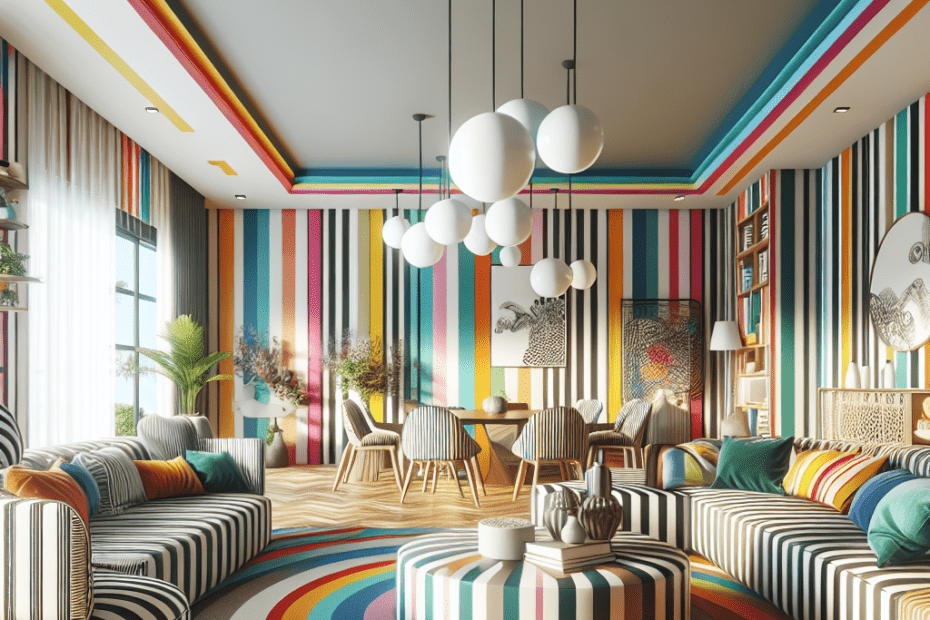Designing with Stripes for a Playful and Dynamic Look
Stripes in interior design have long been a favorite for those looking to add a playful and dynamic look to their spaces. This timeless pattern can bring life and personality to otherwise bland interiors. People often gravitate towards stripes for their ability to add dimension and movement, making rooms feel both more expansive and cohesive. Through this blog post, readers will explore the various ways stripes can be implemented to transform any room into a vibrant and engaging environment.
The Magic of Stripes in Interior Design
Stripes hold a unique place in the world of interior design due to their versatility. They can be bold and attention-grabbing or subtle and calm, depending on how they are utilized. Stripes have the power to trick the eye, making spaces appear larger, taller, or wider than they actually are. According to a study by the Interior Design Association, 67% of designers say that incorporating stripes in a room helps to visually expand the space. Such insights indicate why stripes continue to be a popular choice among those looking to enhance their interiors.
Types and Styles of Stripes
When incorporating stripes into a design, choosing the right type and style is crucial. Although there are various types, the most common are:
- Vertical Stripes: These create the illusion of height, making ceilings appear taller and rooms feel more spacious.
- Horizontal Stripes: These widen spaces, tricking the eye into seeing a broader landscape.
- Diagonal Stripes: These add movement and can bring an energetic feel to the decor.
- Zig-Zag Stripes: Often referred to as chevron, these stripes offer a playful and lively vibe.
By understanding these different styles, designers can skillfully incorporate stripes to achieve a specific atmosphere and ambiance in any room.
Color and Contrast
The impact of stripes is significantly influenced by color and contrast. For a classic and elegant design, one might opt for monochromatic stripes, such as black and white, or shades of gray. On the other hand, colorful stripes, like blue, yellow, or red, can invigorate a space, adding energy and excitement. Research from the Color Insider Group revealed that 76% of users find rooms with contrasting stripes to be more visually stimulating compared to those with plain walls.
The ability to play with colors and contrasts allows designers to match preferences to the room’s function. For example, muted tones might work best in bedrooms for a calming effect, while bold stripes could accentuate a living room’s dynamic and social character.
Materials and Applications
Stripes can be applied across various materials, providing a wide array of choices for designers. They are often seen in:
| Material | Application | Impact |
|---|---|---|
| Wallpaper | Walls | Defines and structures spaces |
| Fabric | Curtains, Upholstery | Adds texture and depth |
| Rugs | Floors | Grounds the room’s design |
| Tiles | Kitchens, Bathrooms | Creates a sleek and modern look |
By thoughtfully choosing materials, they can create various effects and moods, appealing to different styles and preferences while maintaining the playful essence of stripes.
Key Takeaways
- Stripes are a dynamic tool in interior design, offering versatility in style with vertical, horizontal, diagonal, and zig-zag patterns.
- The choice of color and contrast can significantly alter the perception of space, contributing to a room’s aesthetic and ambiance.
- Materials such as wallpaper, fabric, rugs, and tiles provide diverse ways to integrate stripes into the home environment.
- Statistics show that 67% of designers use stripes to visually expand spaces, while 76% of users find contrasting stripes more stimulating.
- Stripes add dimension, movement, and a playful feel, fitting diverse design preferences and functions.
FAQ
- 1. Can stripes make small rooms look larger?
- Yes, vertical stripes can create the illusion of height, making a room feel taller and more spacious.
- 2. Are stripes suitable for minimalist designs?
- Indeed, subtle stripes can add interest to minimalist designs without overwhelming the simplicity of the space.
- 3. How do stripes affect the mood of a room?
- The mood created by stripes largely depends on their color and contrast. Bold and bright stripes can energize, while soft, muted tones can calm the room’s atmosphere.
- 4. What is the best way to incorporate stripes in a small apartment?
- A great way to incorporate stripes in a small space is through vertical striped wallpaper or narrow striped rugs, adding texture without closing in the space.
- 5. Can stripes be used in both traditional and modern designs?
- Absolutely, stripes are timeless and can complement both traditional and modern styles, depending on the color, width, and placement.
